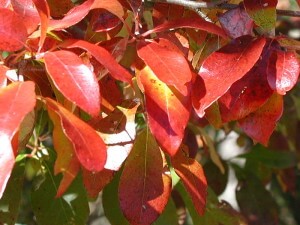
Black Tupelo (Nyssa sylvatica) , also called black gum tree is a North Eastern American native tree producing edible fruit in the fall. There are 2 other species in the genus native to South Eastern US, they are the Ogeechee Lime (Nyssa ogeche) and Water Tupelo (Nyssa aquatica), This article primarily focuses on Nyssa silvatica but many points could apply to either of the other species. Tupelo was a native American food, and the name “tupelo” comes from the native American muscogee language, meaning “swamp tree”, referring to the southern species of tupelo.
Edibility and Culinary Use

The fruit is the only known edible part of the tree. The fruits are very tasty, somewhat sour but sweet enough to enjoy raw, there is no bitterness. There is one large seed in the fruit so the fruits aren’t as fleshy as they look. On the other hand the tree is usually loaded with fruits, and it can grow to be 80’ tall, so as fall progresses the ground gets covered in these small fruits. You can find some good ones there on the ground or pick them off the tree if you can reach the branches. The fruits are also often used to flavor pies, preserves, and drinks.
Health Benefits
There is very little research done on the health benefits of Tupelo fruits.
Key ID Features

Black Tupelo could be a difficult tree to identify. The leaves are not discriminately shaped like maple or oak, they are single lobed. Whenever I see a large tree that has single lobed leaves I usually say “what is that?” and it reminds me that that’s what I usually say when I see a black tupelo. There is one somewhat unique ID feature which is that the mid-height and lower branches grow out of the tree at almost 90 degrees then slope down unlike most trees where they are angled up. Also notice that the tree has many little black fruits in the fall, and a brilliant reddish colored leaf when the leaves change colors.
Conclusion
Black Tupelo is a great edible fruit tree. This is a plant that makes me wonder what a few thousand years of selective breeding would have gotten us, the fruits are not much smaller than wild cherry fruits and cherries are obviously a common fruit today. Native Americans did not engage in the selective breeding of fruit trees as much as Europeans. Black Tupelo is hardy to zone 3, has great fall foliage and delicious fruits, find one or plant one for a great addition to your foraging ventures.
Read our Article on: Safe Foraging

Many of our readers find that subscribing to Eat The Planet is the best way to make sure they don't miss any of our valuable information about wild edibles.
See our privacy policy for more information about ads on this site







7 Responses
We have the black gum (Tupelo) in my area. Have noticed another tree with similar fruits which are round instead of oblong. Leaves are similar but a little different. Would this be one of the other two species? So far I am wary of eating the round fruit. East Texas
Is the fruit toxic to dogs?
From the way our chickens love the little berries, I would definitely assume they are not toxic. The leaves on mine don’t really look waxy the way the ones in a lot of the pictures online look.
The fruit of the Black Gum tree growing alongside the Nature Trail at the high school was not sweet at all when me and the class I was teaching tried some last November. Maybe it wasn’t fully ripened, but it was bitter and sour.
why hasnt my 5 year old 18′ tall nyssa not produced fruit?
My 12 yr old Tupelo just made fruit for the first time this year. Maybe yours needs to mature more
It’s probably a male tree. I have four trees on my property and only one produces berries.